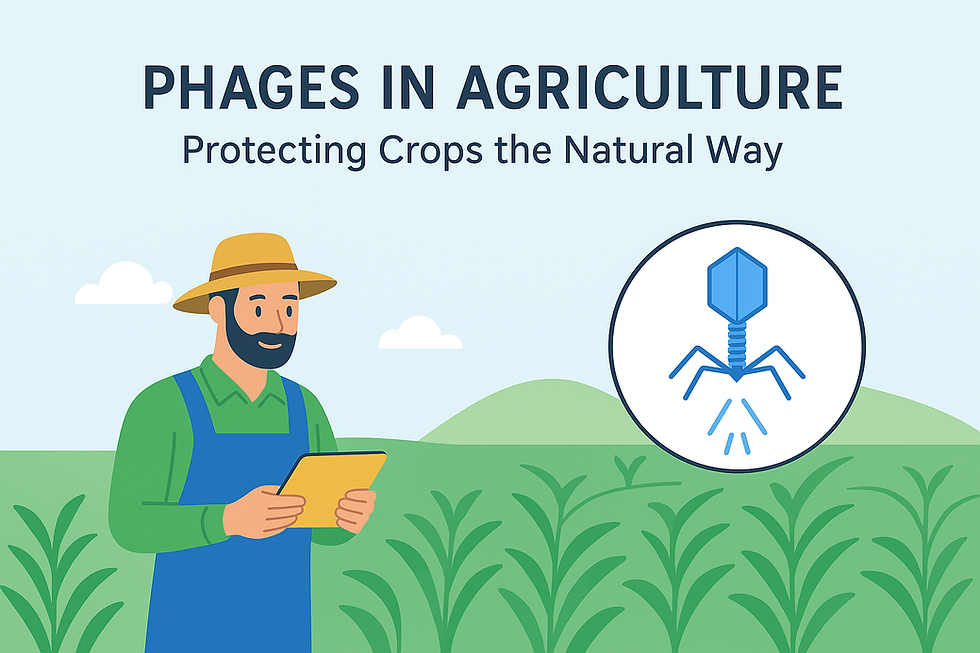Behind the Petri Dish: Inside FWRM Labs’ Phage Discovery Pipeline
- noahfata
- Oct 21
- 2 min read

Where Curiosity Meets Precision
At FWRM Labs, discovery begins with a simple question: How can we find and redefine bacteriophages that solve real-world problems? From the first bacterial culture to a validated phage formulation, every step in our pipeline reflects the intersection of curiosity, precision, and purpose.
Our scientists work across multiple disciplines: microbiology, genomics, and bioinformatics to ensure that each phage we study isn’t just a laboratory finding, but a potential cornerstone for clinical or agricultural innovation.
Step 1: Isolation and Discovery
Every new project starts with phage hunting or isolating bacteriophages from natural environments such as soil, water, or animal microbiomes. Our researchers collect and enrich samples using target bacteria to lure phages out of the microbial ecosystem.
These initial findings are confirmed through plaque assays, where the characteristic clear zones on a bacterial lawn reveal the presence of active phages. From there, isolates are purified, expanded, and logged into our phage library for deeper characterization.
Step 2: Characterization and Host Range Testing
Once a candidate phage is isolated, the next phase focuses on understanding its biology and potential. We evaluate:
Host range: Which bacterial strains the phage can infect
Lytic activity: How efficiently it destroys the target bacteria
Resistance potential: Likelihood of bacterial adaptation
Environmental stability: How it performs under temperature, pH, and UV stress
Each dataset informs whether a phage is suitable for therapeutic or agricultural development and whether it should be paired with others to form a robust, multi-strain cocktail!
Step 3: Genomic Analysis
Modern phage discovery doesn’t stop at observation; it dives into the genome. Using next-generation sequencing and bioinformatics tools, our team analyzes each phage’s DNA to confirm safety (absence of virulence or antibiotic resistance genes) and to uncover unique genetic features. These insights guide formulation design and intellectual property development, ensuring that our partners receive not just a product, but a data-backed foundation for innovation.
Step 4: Formulation and Application Development
A great phage must also be a usable one. That’s why our formulation scientists test various delivery methods: from liquid suspensions and encapsulated blends to sprays and coatings, optimizing for stability, shelf life, and activity in real-world conditions. This stage bridges the gap between discovery and deployment, whether for clinical use, or crop protection.
Step 5: Validation and Partner Collaboration
Finally, promising candidates move into validation studies, where FWRM Labs applies GLP-ready workflows to evaluate safety, efficacy, and reproducibility. We work closely with our partners to tailor testing to their specific goals. Whether it’s regulatory submission, proof-of-concept trials, or large-scale production readiness.
Innovation Through Collaboration
Our phage discovery pipeline isn’t just about finding new viruses, it’s about building partnerships that accelerate progress! By integrating scientific rigor with collaborative development, FWRM Labs helps bridge the gap between microbial research and practical application. From petri dish to product, every breakthrough begins with curiosity and ends with impact.
About FWRM Labs
FWRM Labs is a bacteriophage research and contract research organization (CRO) dedicated to advancing phage science for clinical and agricultural innovation. Through advanced R&D, customized testing, and partner-driven collaboration, we transform microbiological insight into scalable, real-world solutions.



Comments